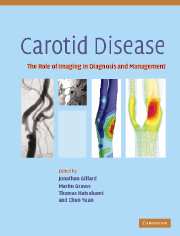Book contents
- Frontmatter
- Contents
- List of contributors
- List of abbreviations
- Introduction
- Background
- Luminal imaging techniques
- 9 Conventional carotid Doppler ultrasound
- 10 Conventional digital subtraction angiography for carotid disease
- 11 Magnetic resonance angiography of the carotid artery
- 12 Computed tomographic angiography of carotid artery stenosis
- 13 Cost-effectiveness analysis for carotid imaging
- Morphological plaque imaging
- Functional plaque imaging
- Plaque modelling
- Monitoring the local and distal effects of carotid interventions
- Monitoring pharmaceutical interventions
- Future directions in carotid plaque imaging
- Index
- References
11 - Magnetic resonance angiography of the carotid artery
from Luminal imaging techniques
Published online by Cambridge University Press: 03 December 2009
- Frontmatter
- Contents
- List of contributors
- List of abbreviations
- Introduction
- Background
- Luminal imaging techniques
- 9 Conventional carotid Doppler ultrasound
- 10 Conventional digital subtraction angiography for carotid disease
- 11 Magnetic resonance angiography of the carotid artery
- 12 Computed tomographic angiography of carotid artery stenosis
- 13 Cost-effectiveness analysis for carotid imaging
- Morphological plaque imaging
- Functional plaque imaging
- Plaque modelling
- Monitoring the local and distal effects of carotid interventions
- Monitoring pharmaceutical interventions
- Future directions in carotid plaque imaging
- Index
- References
Summary
Introduction
Magnetic resonance angiography (MRA) has emerged as one of the leading noninvasive modalities used to image the carotid artery. The core of MRA is its ability to portray blood vessels in a projective format similar to the gold standard, conventional digital subtraction angiography (DSA). The potential advantages of MRA over DSA are, however, numerous and compelling: MRA is less expensive, is the modality that patients tend to prefer, does not require iodinated contrast medium, is an outpatient procedure and more significantly, does not incur the 1–2% risks of neurological complications generally associated with intra-arterial catheterization (Willinsky et al., 2003; U-King-Im et al., 2004a, b). Recent advances in MRA technology, resulting from fast gradients and use of contrast agents has allowed substantial improvement in the quality of MRA examinations, leading to increased confidence of both radiologists and clinicians in the modality. Not surprisingly, this has been followed by the widespread use of MRA in the routine clinical work-up of patients with suspected carotid stenosis. This chapter summarizes the current state of carotid MRA. The first sections deal with the technical aspects of the various types of MRA, including time-of-flight (TOF), phase-contrast and contrast-enhanced MRA and highlight promising future developments as well as potential novel contrast agents. The current utility and efficacy of MRA in clinical practice is then discussed from an evidence-based perspective.
Keywords
- Type
- Chapter
- Information
- Carotid DiseaseThe Role of Imaging in Diagnosis and Management, pp. 140 - 157Publisher: Cambridge University PressPrint publication year: 2006



